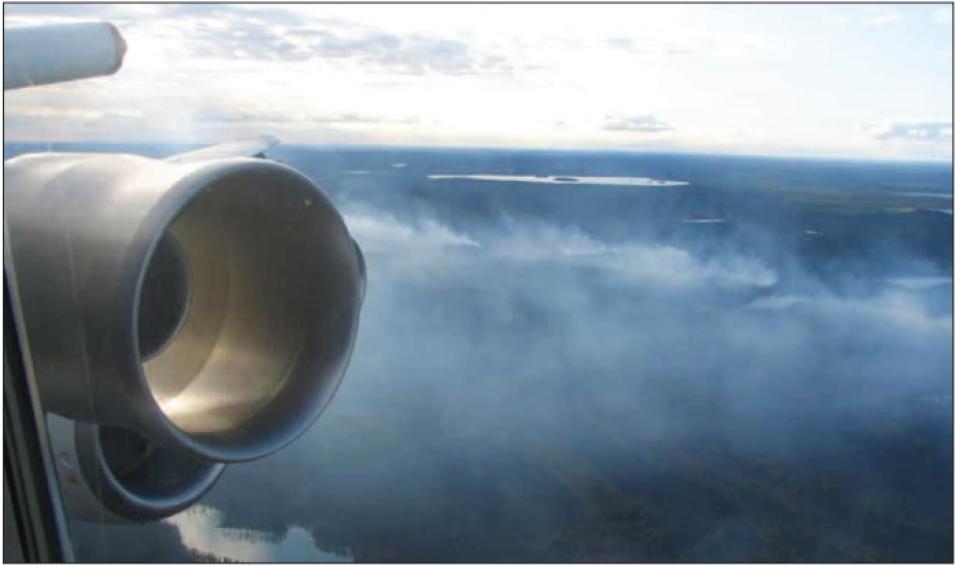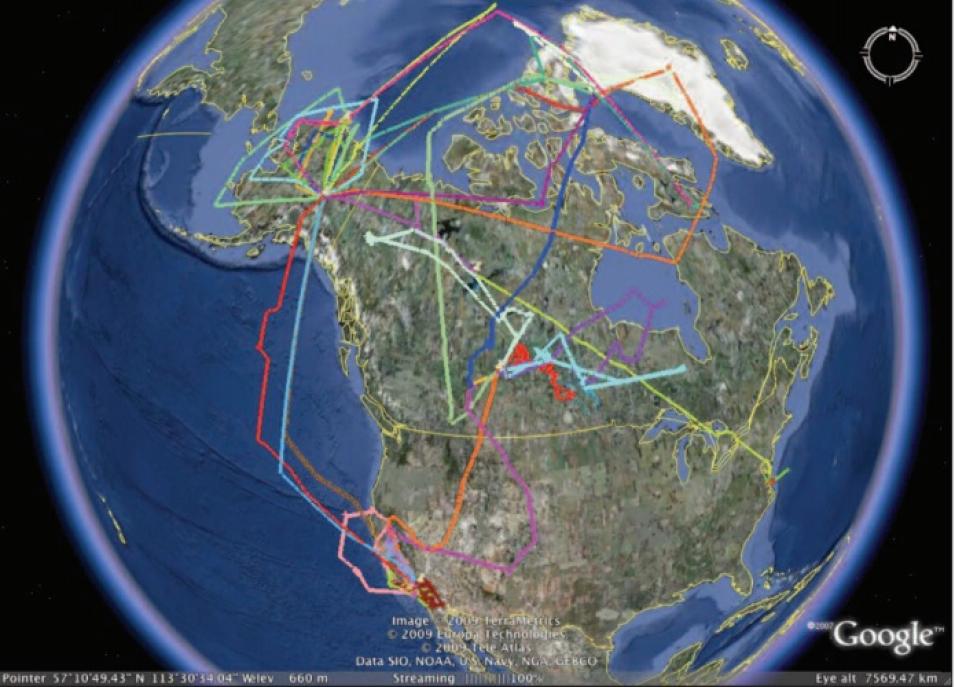ARCTAS researchers also wanted to find out exactly where Arctic haze originates. “For many years, we assumed that Arctic haze came mostly from power plants in Europe,” Emmons said. However, recent studies have shown that pollution from North America and Asia, and forest fires in northern Asia, also contribute to the haze. During ARCTAS, airplanes outfitted with a variety of sensors flew through pollution plumes and measured chemicals that can show what type of combustion initiated the plume. These sensors gathered data that could not be measured with current satellite-based pollution sensors. Emmons said, “Several current satellite instruments measure carbon monoxide, and that gives us a nice picture of pollution plumes around the globe. But there are many sources of carbon monoxide: fires, traffic, and power plants. If we look at the relative contributions of other gas-phase species and aerosols, we can sort out whether a plume came from fires in Canada or anthropogenic pollution in China.”
Finally, ARCTAS researchers took advantage of the multiple research flights to collect data for comparison with existing satellite measurements. “It’s a challenge to get good information over snow- and ice-covered regions,” Emmons said. Just as the reflection off the shiny surface of a glacier makes it hard to see, the reflective ice and snow in the Arctic can make it challenging for satellites to collect accurate data. Collecting data from an airplane at the same place and time that a satellite passes over allows scientists to compare the data. Emmons said, “This is an opportunity to see what the limits of satellite retrievals are in the Arctic, and to get more information out of them.”
ARCTAS researchers are now working to integrate the information collected from the mission into pollution and climate models. Emmons said, “If our models work well for this experiment, we can then do future scenarios, and better understand how climate might change under different conditions.”
Arctic climate and pollution
The Arctic serves as a waste bin for air pollution, which builds and persists through the Arctic spring and summer. But scientists know little about how that pollution may affect regional climate and ecosystems. Scientists hope that research stemming from the ARCTAS field mission will bring some much-needed clarity to the hazy information on the Arctic atmosphere.
The ARCTAS experiment was the largest field mission ever to explore the Arctic atmosphere. Emmons, Olson, and the other researchers who worked on the experiment still have a challenge ahead of them: making sense of the thousands of data points collected during the experiment. Emmons said, “We’re putting everything together now. It’s a pretty complex system, but if we improve our models for regional pollution transport, we could better understand the climate implications of pollution in the Arctic.”
References
Blakelee, R., J. Hall, M. Goodman, P. Parker, L. Freudinger, and M. He. 2007. The Real Time Mission Monitor—A situational awareness tool for managing experiment assets. NASA Science and Technology Conference 2007, 19−21 June 2007, College Park, MD.
NASA aircraft examine impact of forest fires on Arctic climate. https://www.nasa.gov/mission_pages/arctas/summer_deploy.html
National Center for Atmospheric Research. Measuring the Arctic’s haze and smoke. https://opensky.ucar.edu/islandora/object/archives%3A4922/datastream/OBJ/view
Quinn, P. K., G. Shaw, E. Andrews, E. G. Dutton, T. Ruoho-Airola, and S. L. Gong. 2007. Arctic haze: current trends and knowledge gaps. Tellus B 59:1, 99−114.
For more information
NASA Atmospheric Science Data Center (ASDC)
NASA Global Hydrometeorology Resource Center Distributed Active Archive Center (GHRC DAAC)
Arctic Research of the Composition of the Troposphere from Aircraft and Satellites (ARCTAS) Data at ASDC
ARCTAS Mission Page
NASA Real Time Mission Monitor (RTMM)
NASA Research Environment for Vehicle Embedded Analysis
National Center for Atmospheric Research (NCAR) Atmospheric Chemistry Division
| About the data |
| Sensors |
Various airborne sensors |
| Data sets |
Arctic Research of the Composition of the Troposphere from Aircraft and Satellites (ARCTAS):
DC-8 aircraft data
P-3B aircraft data
B200 aircraft data |
| Resolution |
Various |
| DAAC |
NASA Atmospheric Science Data Center (ASDC) |
| About the data tool |
| Tool |
Real Time Mission Monitor |
| Products provided |
Simultaneous aircraft tracking for the NASA DC-8, P-3B, and B200
Satellite imagery, aircraft state information, and surface data sets |
| DAAC |
NASA Global Hydrometeorology Resource Center Distributed Active Archive Center (GHRC DAAC) |


